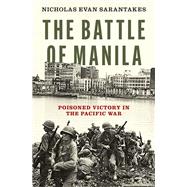
The Battle of Manila Poisoned Victory in the Pacific War
by Sarantakes, Nicholas EvanBuy New
Rent Book
Rent Digital
Used Book
We're Sorry
Sold Out
How Marketplace Works:
- This item is offered by an independent seller and not shipped from our warehouse
- Item details like edition and cover design may differ from our description; see seller's comments before ordering.
- Sellers much confirm and ship within two business days; otherwise, the order will be cancelled and refunded.
- Marketplace purchases cannot be returned to eCampus.com. Contact the seller directly for inquiries; if no response within two days, contact customer service.
- Additional shipping costs apply to Marketplace purchases. Review shipping costs at checkout.
Summary
In 1945 the United States and Japan fought the largest and most devastating land battle of their war in the Pacific, a month-long struggle for the city of Manila. The only urban fighting in the Pacific theater, the Battle of Manila was the third-bloodiest battle of World War II, behind Leningrad and Berlin. It was a key piece of the campaign to retake control of the Philippine Islands, which itself signified the culmination of the war, breaking the back of Japanese strategic power and sealing its outcome.
In The Battle of Manila, Nicholas Sarantakes offers the first in-depth account of this crucial campaign from the American, Japanese, and, significantly, Filipino perspective. Fighting was building by building, with both sides forced to adapt to the new combat environment. None of the U.S. units that entered Manila had any previous training in urban warfare--yet, Sarantakes shows, they learned on the fly how to use tanks, flamethrowers, air, and artillery assets in support of infantry assaults. Their effective use of these weapons was an important factor in limiting U.S. casualties, even as it may also have contributed to a catastrophic loss of civilian lives.
The battle was a strategic U.S. victory, but Sarantakes reveals how closely it hinged upon the interplay between a series of key decisions in both U.S. and Japanese headquarters, and a professional culture in the U.S. military that allowed the Americans to adapt faster and in more ways than their opponents. Among other aspects of the conflict, The Battle of Manila explores the importance of the Filipino guerillas on the ground, the use of irregular warfare, the effective use of intelligence, the impact of military education, and the limits of Japanese resistance.
Ultimately, Sarantakes shows Manila to be a major turning in both World War II and American history. Once the United States regained control of the city, Japan was in a checkmate situation. Their defeat was certain, and it was clear that the United States would be the dominate political power in post-war Asia and the Pacific. This fascinating account shines a light on one of the war's most under-represented and highly significant moments.
Author Biography
Table of Contents
Introduction: Poisoned Victory
Chapter 1: MacArthur's War, MacArthur's Men
Chapter 2: The Japanese and the Filipinos
Chapter 3: Returning to Luzon
Chapter 4: "Easy Soldiering"
Chapter 5: The Race to Manila
Chapter 6: The Other Race to Manila
Chapter 7: Santo Tomas
Chapter 8: Game of Death
Chapter 9: Way of the Dragon
Chapter 10: Tomorrow is Yesterday
Chapter 11: A Taste of Armageddon: Life Behind Japanese Lines
Chapter 12: Thunderstorm
Chapter 13: Spector of the Gun
Chapter 14: This Side of Paradise: Life Behind American Lines
Chapter 15: Corregidor
Chapter 16: Patterns of Force
Chapter 17: The House that Miguel López de Legazpi Built
Chapter 18: The Savage Curtain
Chapter 19: The City on the Edge of Forever
Conclusion
Bibliographic Statement
An electronic version of this book is available through VitalSource.
This book is viewable on PC, Mac, iPhone, iPad, iPod Touch, and most smartphones.
By purchasing, you will be able to view this book online, as well as download it, for the chosen number of days.
Digital License
You are licensing a digital product for a set duration. Durations are set forth in the product description, with "Lifetime" typically meaning five (5) years of online access and permanent download to a supported device. All licenses are non-transferable.
More details can be found here.
A downloadable version of this book is available through the eCampus Reader or compatible Adobe readers.
Applications are available on iOS, Android, PC, Mac, and Windows Mobile platforms.
Please view the compatibility matrix prior to purchase.
